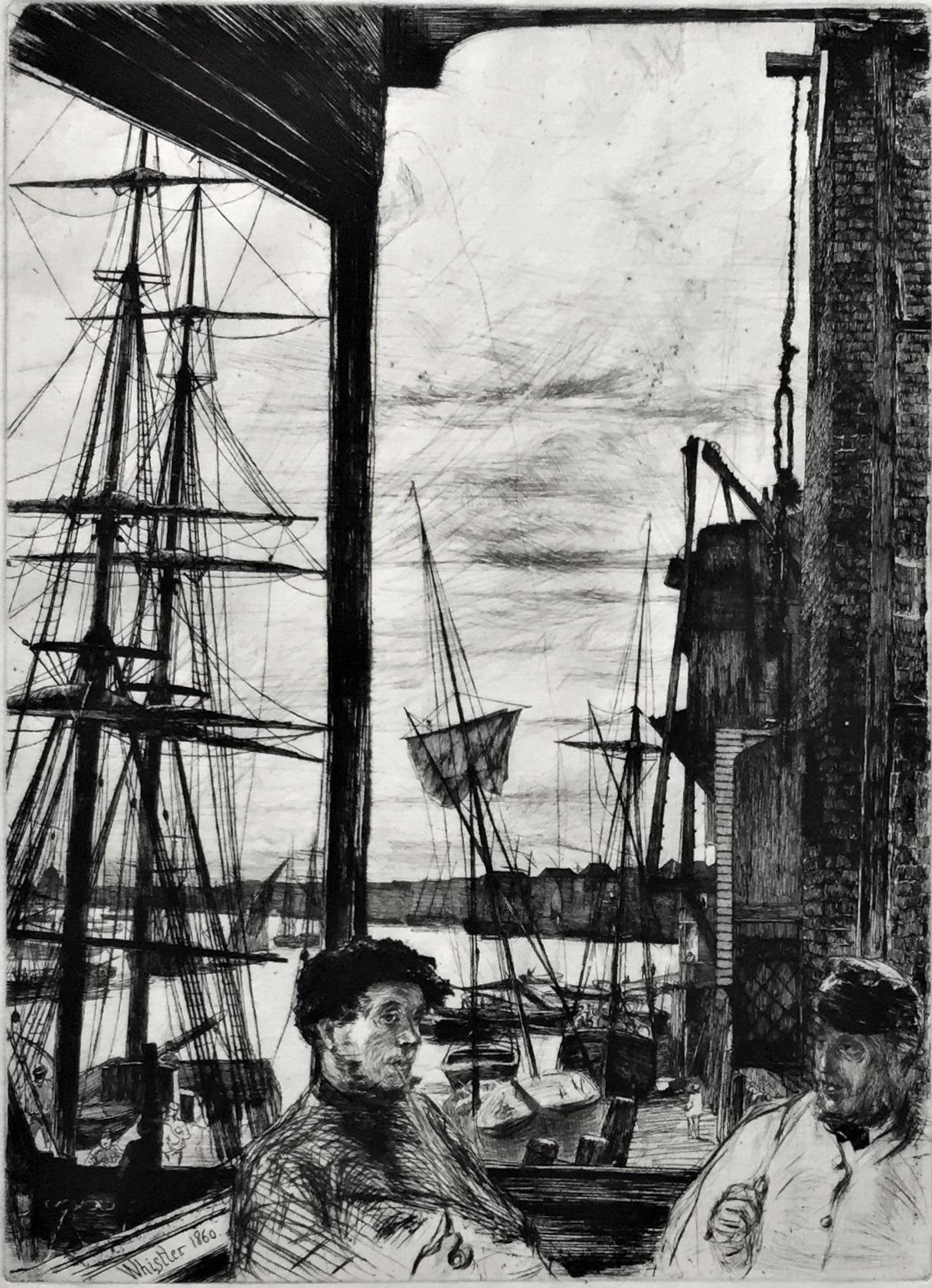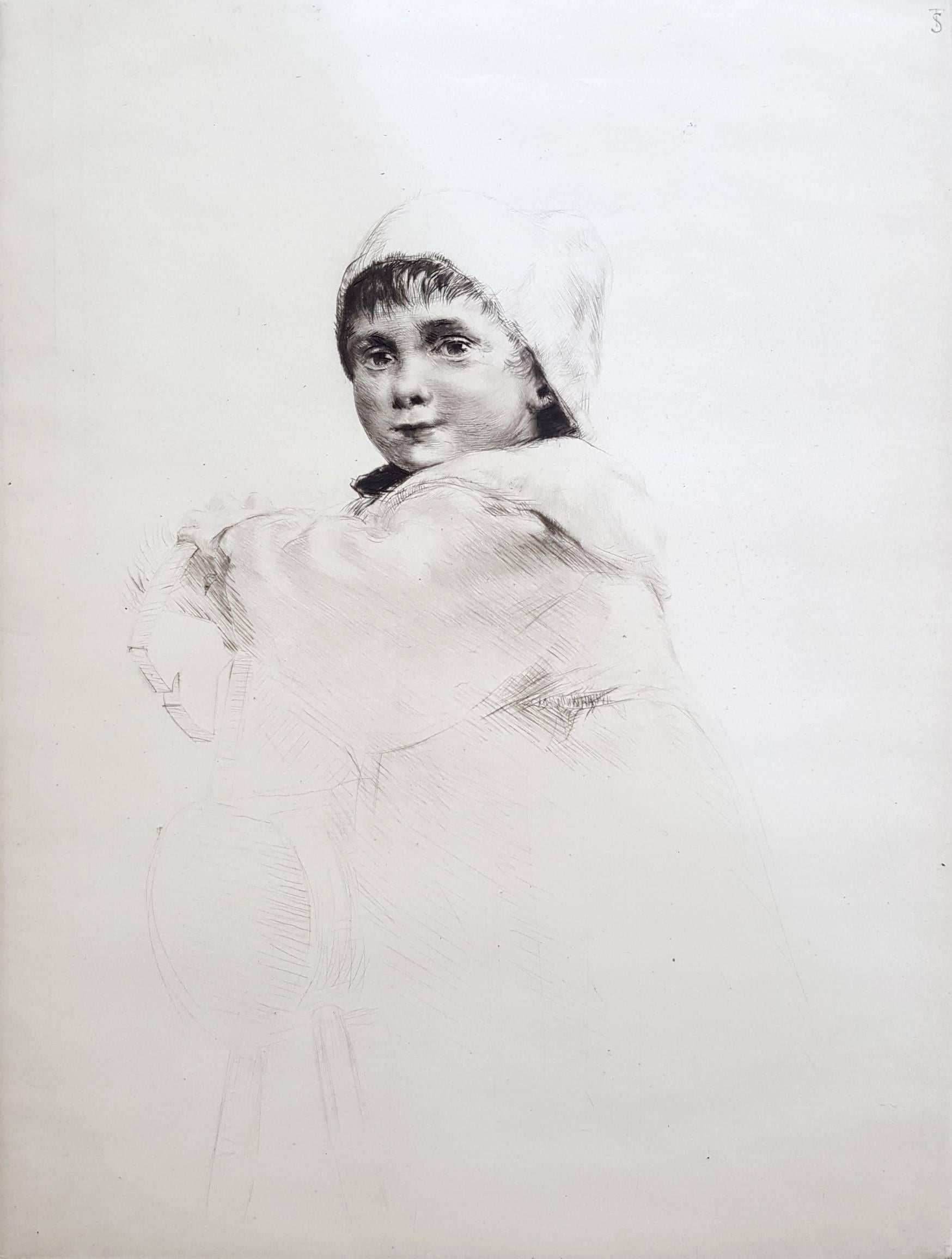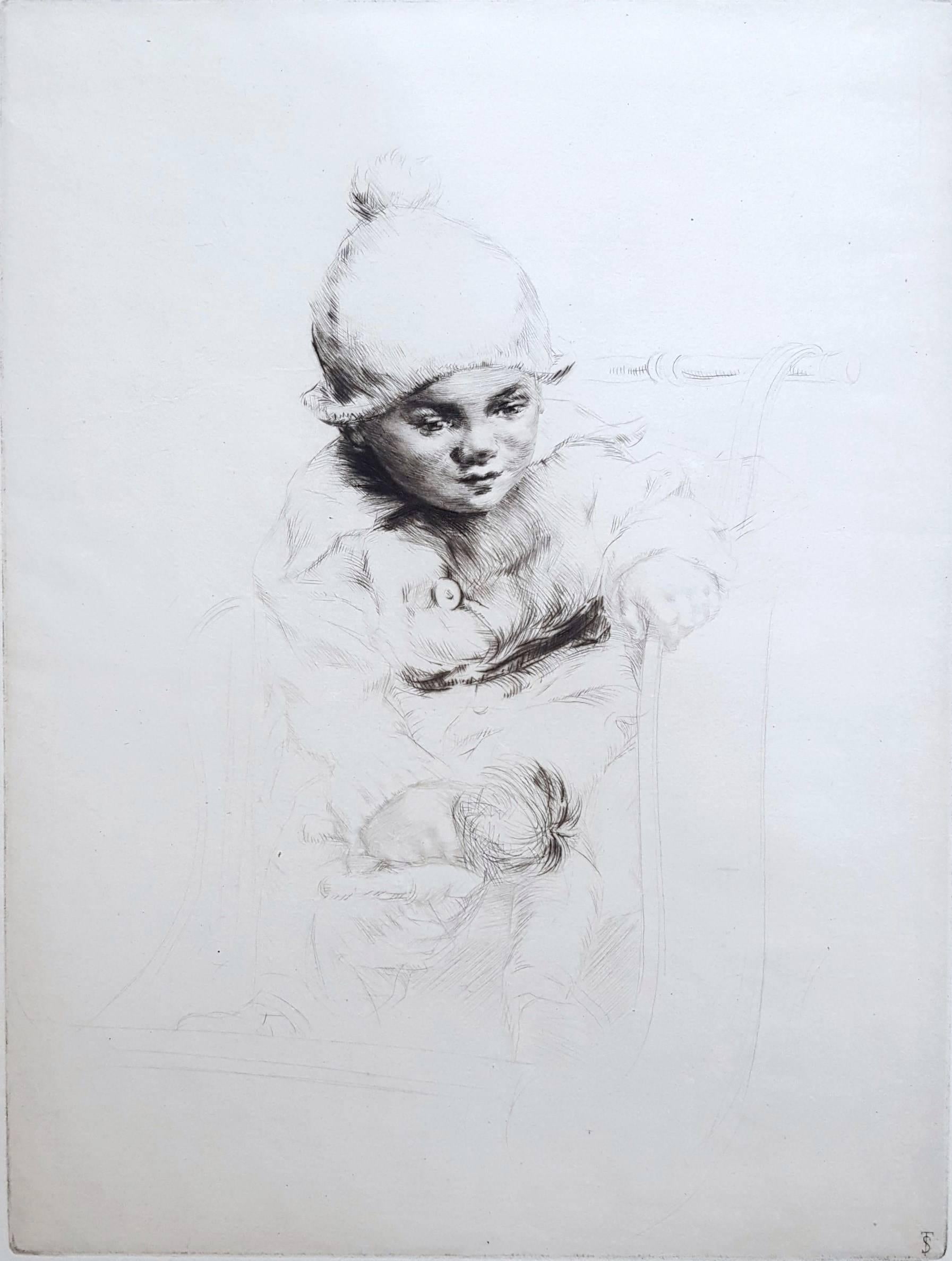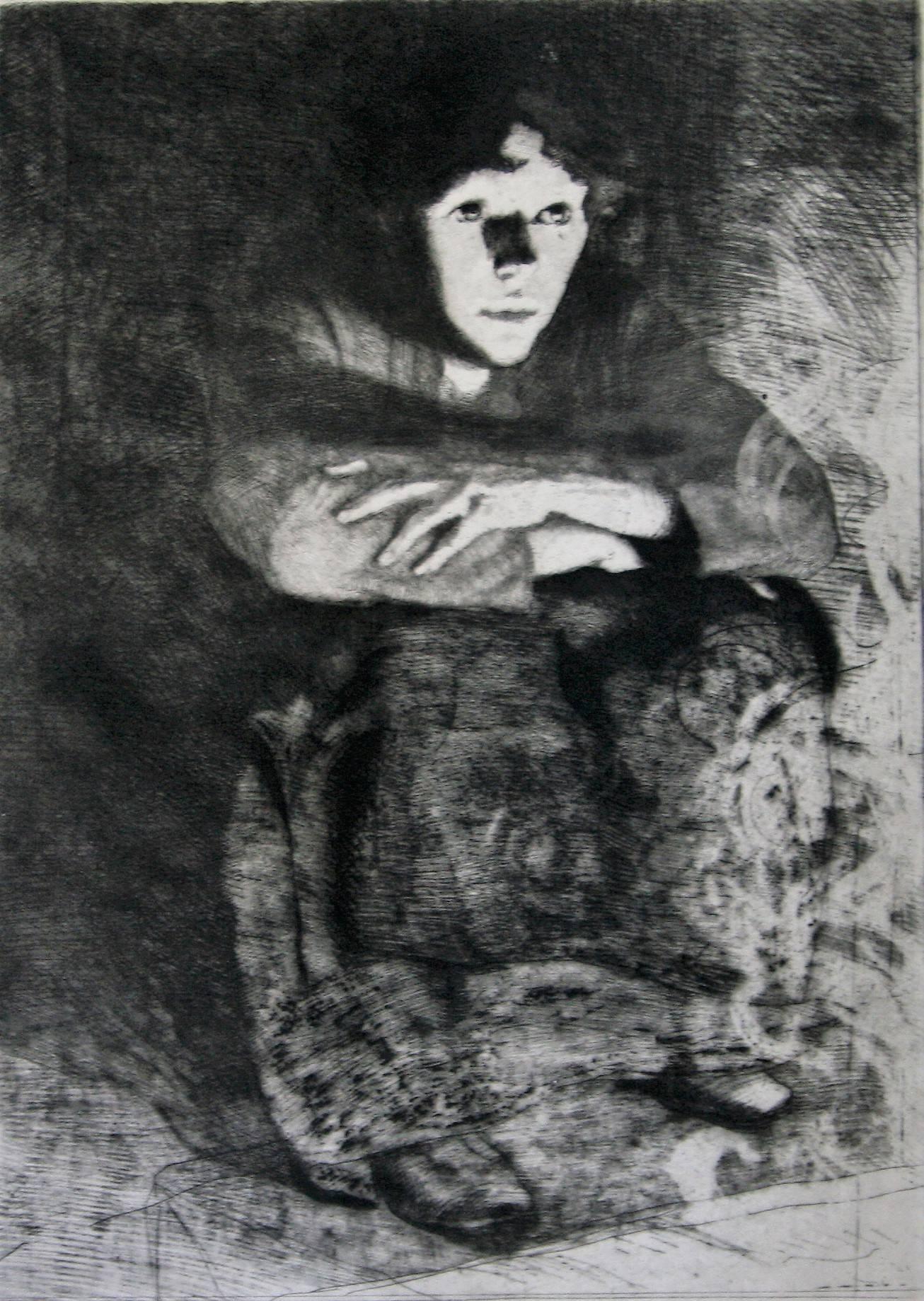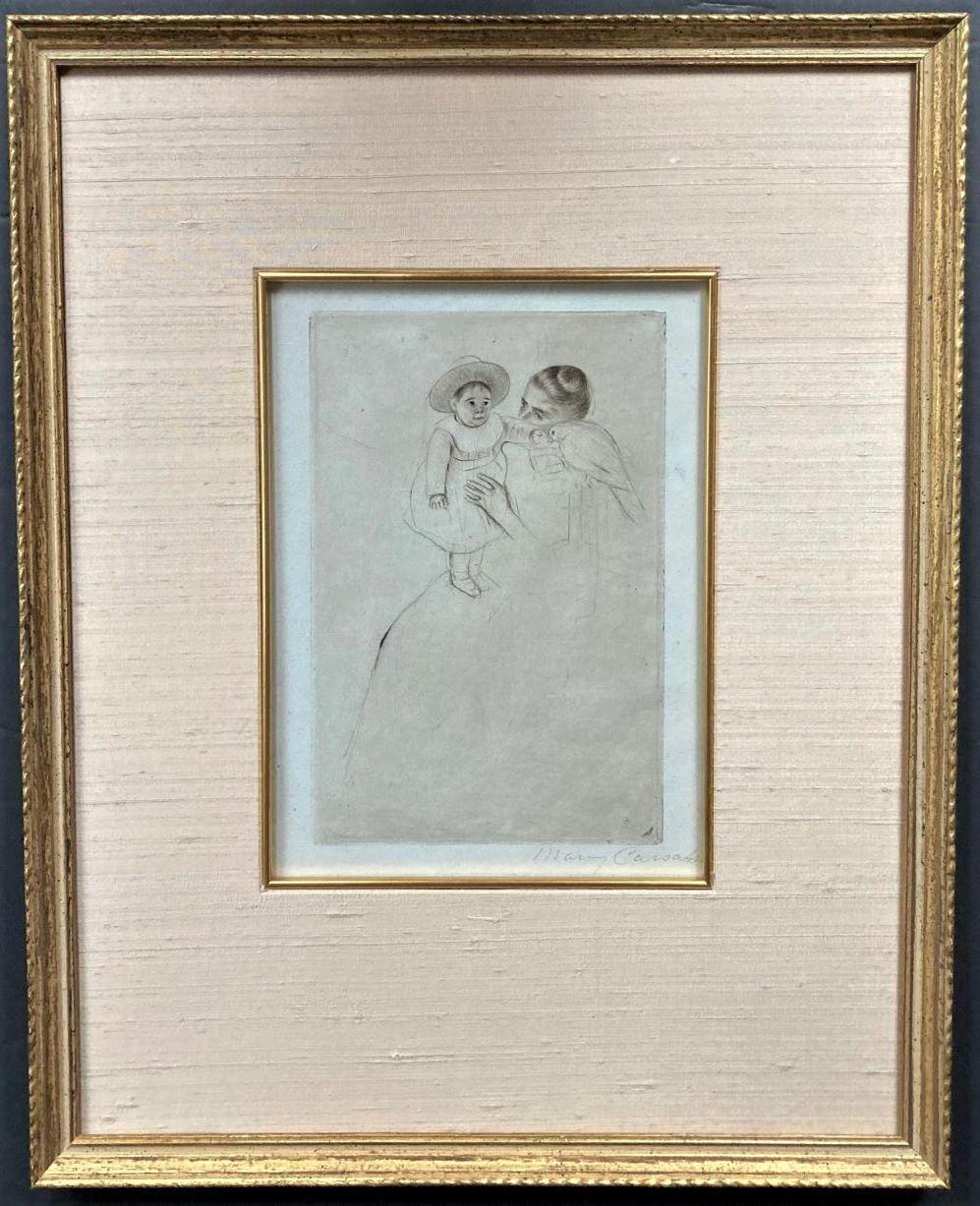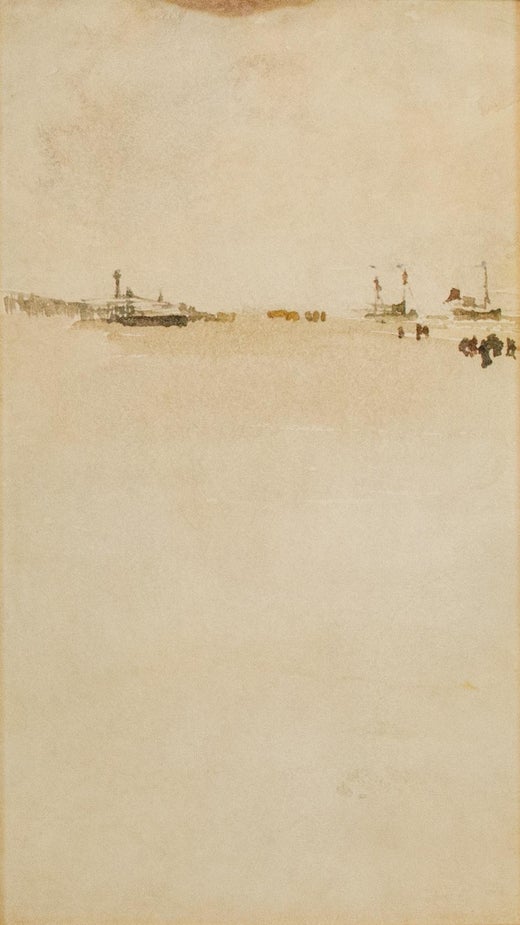James Abbott McNeill WhistlerJ. Becquet, Sculptor1859
1859
About the Item
- Creator:James Abbott McNeill Whistler (1834-1903, American)
- Creation Year:1859
- Dimensions:Height: 9.88 in (25.1 cm)Width: 7.5 in (19.05 cm)
- Medium:
- Movement & Style:
- Period:
- Condition:This impression printed on a fine laid tissue that has been backed for support. There are two small repairs to the paper, outside of the plate mark and visible only from the verso.
- Gallery Location:Fairlawn, OH
- Reference Number:
James Abbott McNeill Whistler
James Abbott McNeill Whistler was an American artist active during the American Gilded Age and based primarily in the United Kingdom. Whistler was born on July 11, 1834, in Lowell. During his formative years in Paris in the 1850s, Whistler was influenced by the injunctions of the poet and theorist Charles Baudelaire that artists should take subjects from modern life and seek a new beauty in the teeming cities. Whistler's first major suite of prints, his French Set brought critical acclaim but disappointing sales. Seeking more generous patrons, he moved to London in 1859. Initially, under the influence of his brother-in-law Francis Seymour Haden, a pioneer of the etching revival, he began a series of superbly observed and finely detailed views of the River Thames with its shipping, thriving wharves and picturesque characters. In his Thames Set etchings, Whistler often introduced the figures of workmen, boatmen or loungers in the foregrounds. Whistler died on July 17, 1903, in London.
- ShippingRetrieving quote...Ships From: Fairlawn, OH
- Return PolicyA return for this item may be initiated within 10 days of delivery.
- Femme AssieBy Pierre Georges JeanniotLocated in Fairlawn, OHSigned in pencil lower left; publisher stamp lower right 100 (88/100)Category
1910s Portrait Prints
MaterialsEtching, Drypoint
- Chinois inventa, dit-on, la poudre a canon, nous en fit donBy Georges RouaultLocated in Fairlawn, OHChinois inventa, dit-on, la poudre a canon, nous en fit don (The Chinese invented gunpowder, they say, and made is a gift of it) Aquatint, roulette, drypoint, acid bite, and scorper, 1926 From: Miserere, Plate 38 Initially started by Ambrose Vollard, this portfolio was published in 1948 by Editions de l'Etoile Filante, Paris This image is the cover illustration for the 1938 MOMA catalog...Category
1920s French School Portrait Prints
MaterialsDrypoint, Aquatint
- Darius IIBy Darius StewardLocated in Fairlawn, OHSigned in pencil lower right Edition: 3 impressions Signed, dated and annotated “1 of 3” Exhibited: Zygote Press, Cleveland, 2016 Tregoning & Co. 2017Category
2010s Contemporary Figurative Prints
MaterialsDrypoint
- Woman's Head in Profile - Woman's Head in Profile (left) (Havard)By Elie NadelmanLocated in Fairlawn, OHWoman's Head in Profile - Woman's Head in Profile (left) (Havard) Drypooint, 1920 Unsigned (as usual) From: The Drypoints of Elie Nadelman, 21 unpublished prints by the sculptor, pro...Category
1920s American Modern Portrait Prints
MaterialsDrypoint
- If you're too cool, you lose.By Darius StewardLocated in Fairlawn, OHSigned, dated and numbered in pencil Printer: Rebekah Wilhelm, Zygote Press, Cleveland Created at Zygote Press, Cleveland, 2015, while the artist was an Artist in Residence. Exhib...Category
2010s Contemporary Figurative Prints
MaterialsDrypoint
- Miss TaylorBy Paul César HelleuLocated in Fairlawn, OHMiss Taylor Drypoint, c. 1900 Signed in pencil lower left (see photo) Small edition, about 10 Very rich impression, full of burr Condition: Excellent Image size: 21-1/4 x 13-1/4" Sheet size: 25 3/8 x 18 5/8" Reference: Montesquiou XII Paul César Helleu was born in Vannes, Brittany, France. His father, who was a customs inspector, died when Helleu was in his teens. Despite opposition from his mother, he then went to Paris and studied at Lycée Chaptal. In 1876, at age 16, he was admitted to the École des Beaux-Arts, beginning academic training in art with Jean-Léon Gérôme. Helleu attended the Second Impressionist Exhibition in the same year, and made his first acquaintances with John Singer Sargent, James McNeill Whistler, and Claude Monet. He was struck by their modern, bold alla prima technique and outdoor scenes, so far removed from the studio. Following graduation, Helleu took a job with the firm Théodore Deck Ceramique Française hand-painting fine decorative plates. At this same time, he met Giovanni Boldini, a portrait painter with a facile, bravura style, who became a mentor and comrade, and strongly influenced his future artistic style. When he was 18 years old, Helleu established a close friendship with John Singer Sargent, four years his senior, that was to last his lifetime. Already becoming established, Sargent was receiving commissions for his work. Helleu had not sold anything, and was deeply discouraged almost to the point of abandoning his studies. When Sargent heard this, he went to Helleu and picked one of his paintings, praising his technique. Flattered that Sargent would praise his work, he offered to give it to him. Sargent replied, "I shall gladly accept this, Helleu, but not as a gift. I sell my own pictures, and I know what they cost me by the time they are out of my hand. I should never enjoy this pastel if I hadn't paid you a fair and honest price for it." With this he paid him a thousand-franc note. Helleu was commissioned in 1884 to paint a portrait of a young woman named Alice Guérin (1870–1933). They fell in love, and married on 28 July 1886. Throughout their lives together, she was his favourite model. Charming, refined and graceful, she helped introduce them to the aristocratic circles of Paris, where they became popular fixtures. On a trip to London with Jacques-Émile Blanche in 1885, Helleu met Whistler again and visited other prominent artists. His introduction to James Jacques Tissot, an accomplished society painter from France who made his career in England, proved a revelation. In Tissot, Helleu saw, for the first time, the possibilities of drypoint etching with a diamond point stylus directly on a copper plate. Helleu quickly became a virtuoso of the technique, drawing with the same dynamic and sophisticated freedom with his stylus as with his pastels. His prints were very well received, and they had the added advantage that a sitter could have several proofs printed to give to relations or friends. Over the course of his career, Helleu produced more than 2,000 drypoint prints. Soon, Helleu was displaying works to much acclaim at several galleries. Degas encouraged him to submit paintings to the Eighth Impressionist Exhibition in May and June 1886. The show was installed in a Paris apartment at 1 rue Laffitte, which ran concurrently with the official Salon that year to make a statement. Although 17 artists joined the famous exhibit that included the first Neo-Impressionistic works, Helleu, like Monet, refused to participate. Paul Helleu Sketching with His Wife (1889), by John Singer Sargent, The Brooklyn Museum, New York In 1886, Helleu befriended Robert de Montesquiou, the poet and aesthete, who bought six of his drypoints to add to his large print collection. Montesquiou later wrote a book about Helleu that was published in 1913 with reproductions of 100 of his prints and drawings. This volume remains the definitive biography of Helleu. Montesquiou introduced Helleu to Parisian literary salons, where he met Marcel Proust, who also became a friend. Proust created a literary picture of Helleu in his novel Remembrance of Things Past as the painter Elstir. (Later, Helleu engraved a well-known portrait of Proust on his deathbed.) Montesquiou's cousin, the Countess Greffulhe, enabled Helleu to expand his career as a portrait artist to elegant women in the highest ranks of Paris society, portraits that provide the basis for his modern reputation. His subjects included the Duchess of Marlborough, the Marchesa Casati...Category
Early 1900s Art Nouveau Portrait Prints
MaterialsDrypoint
- RotherhitheBy James Abbott McNeill WhistlerLocated in Storrs, CTRotherhithe (Originally published as Wapping). 1860. Etching. Kennedy catalog 66 state iii; Glasgow catalog 70. state vi. 10 3/4 x 7 3/4 (sheet 12 7/8 x 9 1/2). Series: "Sixteen Etc...Category
Mid-19th Century American Impressionist Figurative Prints
MaterialsDrypoint, Etching
- Molly /// Antique Victorian Etching Portrait Figurative British Children ChildBy Sidney TushinghamLocated in Saint Augustine, FLArtist: Sidney Tushingham (English, 1884-1968) Title: "Molly" *Signed by Tushingham in pencil lower right. It is also monogram signed in the plate (printed signature) upper right Cir...Category
1910s Impressionist Portrait Prints
MaterialsEtching, Intaglio, Drypoint, Laid Paper
- Peggy /// Antique Victorian Etching Portrait Figurative British Children ChildBy Sidney TushinghamLocated in Saint Augustine, FLArtist: Sidney Tushingham (English, 1884-1968) Title: "Peggy" *Signed by Tushingham in pencil lower right. It is also monogram signed in the plate (printed signature) lower right Cir...Category
1910s Impressionist Portrait Prints
MaterialsEtching, Intaglio, Drypoint, Laid Paper
- Dans les Cendres (In the embers)By Albert BesnardLocated in Storrs, CTDans les Cendres (In the embers). 1887. Delteil catalog 67 state iii. State after the plate was cut down and a second figure eliminated (the two earlier states are of the greatest rarity). Etching, drypoint and roulette. 16 3/4 x 12 1/8 (sheet 19 1/2 x 14). Edition 50. Illustrated: Print Collector's Quarterly 9 (1921): 254. A very rich impression with plate tone and drypoint burr, printed on simili-japon. Provenance: Frederick Keppel & Co. This is one of the artist's most striking images. Signed in pencil. Housed in 25 x 20-inch archival mat, suitable for framing. Paul Albert Besnard, was an impressionist painter. In 1866, the seventeen-year-old son of artist parents began his studies at the École des Beaux-Arts Paris. In 1874, Besnard won the important Prix de Rome, with which the academy distinguished young talent. A portion of the scholarship is a stay of several years in Rome. Besnard married Charlotte Dubray, a sculptress, during this time in Rome. The couple lived in England, where Besnard exhibited at the Royal Academy London, between 1881 and 1884. He became involved with English portrait painting during this period, which had a lasting influence on his work. In the years that followed, Besnard broke with the academic tradition. In 1886, he presented the portrait of Madame Roger Jourdain...Category
Late 19th Century Impressionist Figurative Prints
MaterialsDrypoint, Etching
- VenusBy James Abbott McNeill WhistlerLocated in Storrs, CTVenus. 1859. Etching and drypoint. Kennedy catalog 59 state ii; Glasgow catalog 60 state ii. 6 x 9 (sheet 8 x 11 3/16). Glasgow records 27 known impressions. A very rich impression p...Category
Mid-19th Century American Impressionist Nude Prints
MaterialsEtching, Drypoint
- Hélène of Septeuil (enfant au perroquet) (child with a parakeet).By Mary CassattLocated in Storrs, CTHélène of Septeuil (enfant au perroquet) (child with a parakeet). c. 1889-1890. Drypoint. Breeskin, 134.v. 9 3/8 x 6 1/4 (sheet 15 3/4 x 9 7/8). A rich impression with burr and plate...Category
19th Century Impressionist Portrait Prints
MaterialsDrypoint, Watercolor
